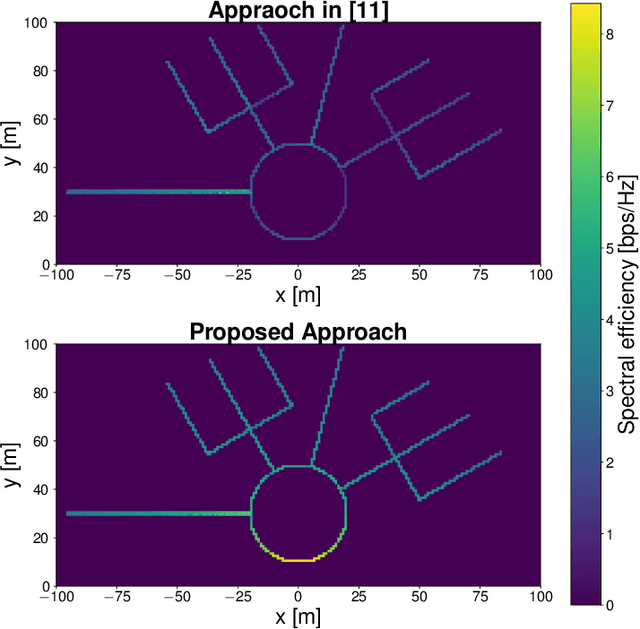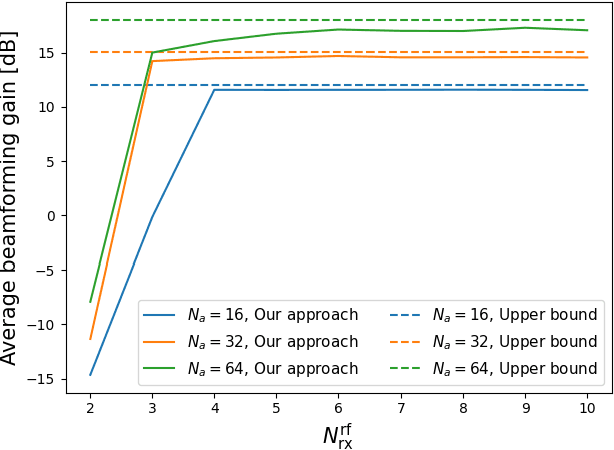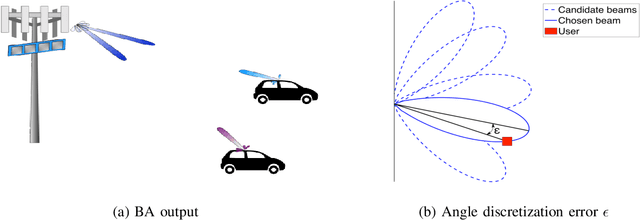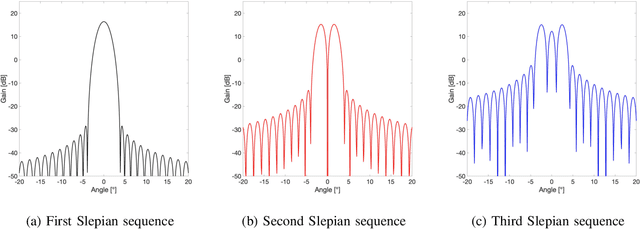Fernando Pedraza
Distributed Beam Alignment in sub-THz D2D Networks
Dec 20, 2024



Abstract:Devices in a device-to-device (D2D) network operating in sub-THz frequencies require knowledge of the spatial channel that connects them to their peers. Acquiring such high dimensional channel state information entails large overhead, which drastically increases with the number of network devices. In this paper, we propose an accelerated method to achieve network-wide beam alignment in an efficient way. To this aim, we consider compressed sensing estimation enabled by a novel design of pilot sequences. Our designed pilots have constant envelope to alleviate hardware requirements at the transmitters, while they exhibit a "comb-like"' spectrum that flexibly allocates energy only on certain frequencies. This design enables multiple devices to transmit thier pilots concurrently while remaining orthogonal in frequency, achieving simultaneous alignment of multiple devices. Furthermore, we present a sequential partitioning strategy into transmitters and receivers that results in logarithmic scaling of the overhead with the number of devices, as opposed to the conventional linear scaling. Finally, we show via accurate modeling of the indoor propagation environment and ray tracing simulations that the resulting sub-THz channels after successful beamforming are approximately frequency flat, therefore suitable for efficient single carrier transmission without equalization. We compare our results against an "802.11ad inspired" baseline and show that our method is capable to greatly reduce the number of pilots required to achieve network-wide alignment.
Compressed Sensing Inspired User Acquisition for Downlink Integrated Sensing and Communication Transmissions
Jul 01, 2024Abstract:This paper investigates radar-assisted user acquisition for downlink multi-user multiple-input multiple-output (MIMO) transmission using Orthogonal Frequency Division Multiplexing (OFDM) signals. Specifically, we formulate a concise mathematical model for the user acquisition problem, where each user is characterized by its delay and beamspace response. Therefore, we propose a two-stage method for user acquisition, where the Multiple Signal Classification (MUSIC) algorithm is adopted for delay estimation, and then a least absolute shrinkage and selection operator (LASSO) is applied for estimating the user response in the beamspace. Furthermore, we also provide a comprehensive performance analysis of the considered problem based on the pair-wise error probability (PEP). Particularly, we show that the rank and the geometric mean of non-zero eigenvalues of the squared beamspace difference matrix determines the user acquisition performance. More importantly, we reveal that simultaneously probing multiple beams outperforms concentrating power on a specific beam direction in each time slot under the power constraint, when only limited OFDM symbols are transmitted. Our numerical results confirm our conclusions and also demonstrate a promising acquisition performance of the proposed two-stage method.
Extended Target Parameter Estimation and Tracking with an HDA Setup for ISAC Applications
Aug 16, 2023Abstract:We investigate radar parameter estimation and beam tracking with a hybrid digital-analog (HDA) architecture in a multi-block measurement framework using an extended target model. In the considered setup, the backscattered data signal is utilized to predict the user position in the next time slots. Specifically, a simplified maximum likelihood framework is adopted for parameter estimation, based on which a simple tracking scheme is also developed. Furthermore, the proposed framework supports adaptive transmitter beamwidth selection, whose effects on the communication performance are also studied. Finally, we verify the effectiveness of the proposed framework via numerical simulations over complex motion patterns that emulate a realistic integrated sensing and communication (ISAC) scenario.
Simultaneous Communication and Tracking in Arbitrary Trajectories via Beam-Space Processing
Mar 29, 2022



Abstract:In this paper, we develop a beam tracking scheme for an orthogonal frequency division multiplexing (OFDM) Integrated Sensing and Communication (ISAC) system with a hybrid digital analog (HDA) architecture operating in the millimeter wave (mmWave) band. Our tracking method consists of an estimation step inspired by radar signal processing techniques, and a prediction step based on simple kinematic equations. The hybrid architecture exploits the predicted state information to focus only on the directions of interest, trading off beamforming gain, hardware complexity and multistream processing capabilities. Our extensive simulations in arbitrary trajectories show that the proposed method can outperform state of the art beam tracking methods in terms of prediction accuracy and consequently achievable communication rate, and is fully capable of dealing with highly non-linear dynamic motion patterns.
Beam Refinement and User State Acquisition via Integrated Sensing and Communication with OFDM
Sep 21, 2021



Abstract:The performance of millimeter wave (mmWave) communications strongly relies on accurate beamforming both at base station and user terminal sides, referred to as beam alignment (BA). Existing BA algorithms provide initial yet coarse angle estimates as they typically use a codebook of a finite number of discreteized beams (angles). Towards emerging applications requiring timely and precise tracking of dynamically changing state of users, we consider a system where a base station with a co-located radar receiver estimates relevant state parameters of users and simultaneously sends OFDM-modulated data symbols. In particular, based on a hybrid digital analog data transmitter/radar receiver architecture, we propose a simple beam refinement and initial state acquisition scheme that can be used for beam and user location tracking in a dynamic environment. Numerical results inspired by IEEE802.11ad parameters demonstrate that the proposed method is able to improve significantly the communication rate and further achieve accurate state estimation.
 Add to Chrome
Add to Chrome Add to Firefox
Add to Firefox Add to Edge
Add to Edge